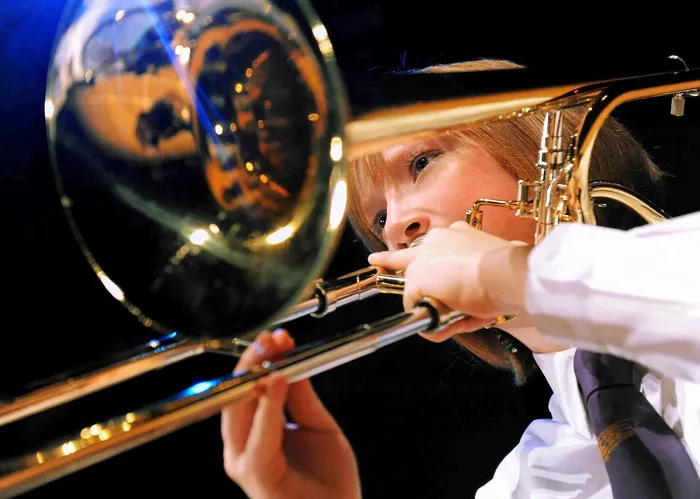In the world of brass instruments, the trombone holds a distinguished place, renowned for its rich, resonant tones and versatility across various musical genres. Among its variations, the valve trombone stands out as a unique and captivating instrument, offering a compelling alternative to its traditional slide counterpart. In this comprehensive guide, we delve into the realm of the valve trombone, exploring its construction, playing techniques, and invaluable advice for aspiring musicians. Whether you’re a seasoned trombonist seeking to expand your repertoire or a novice eager to embark on a musical journey, this article serves as your gateway to unlocking the secrets of mastering the valve trombone.
Understanding Valve Trombone
The valve trombone is a unique brass instrument that offers a distinct alternative to its more traditional slide counterpart. While both instruments belong to the same family, the valve trombone utilizes piston valves, similar to those found on trumpets and other brass instruments, instead of a slide mechanism for changing pitches. Understanding the construction and mechanics of the valve trombone is essential for aspiring musicians looking to master this versatile instrument.
Valve trombones share many similarities with their slide counterparts in terms of overall structure and playing technique. Like the traditional trombone, the valve trombone features a long cylindrical tube with a flared bell at one end. However, instead of manipulating a slide to produce different pitches, valve trombonists rely on a set of piston valves located along the instrument’s body. These valves divert the airflow through various lengths of tubing, altering the pitch produced when the player presses down on the valve buttons.
How to Play Valve Trombone
Playing the valve trombone requires a combination of proper technique, embouchure control, and a keen understanding of musical fundamentals. Whether you’re a seasoned trombonist looking to expand your skills or a beginner eager to learn a new instrument, mastering the basics is crucial for success.
To begin, familiarize yourself with the layout of the valve trombone. Hold the instrument with your left hand supporting the weight of the instrument while your right hand operates the valve buttons. Ensure a comfortable and relaxed posture, with your shoulders back and your feet planted firmly on the ground.
Next, establish a proper embouchure by placing your lips firmly against the mouthpiece and blowing air through the instrument. Experiment with different lip tensions and air pressures to produce a clear and resonant tone. Remember to maintain consistent airflow and avoid excessive tension in your facial muscles.
Once you’ve developed a solid embouchure, start practicing basic scales and exercises to improve your finger dexterity and valve coordination. Focus on playing each note evenly and accurately, paying attention to intonation and tone quality. Gradually increase the speed and complexity of your exercises as you become more comfortable with the instrument.
As you progress, experiment with various articulation techniques, such as tonguing and slurring, to add expression and nuance to your playing. Practice articulating cleanly and precisely, aiming for seamless transitions between notes. Additionally, work on dynamic control, mastering the ability to play softly and loudly with control and finesse.
Advice for Practicing Trombone
Effective practice is essential for honing your skills and mastering the valve trombone. Whether you’re a beginner or an experienced musician, incorporating thoughtful and structured practice routines into your daily schedule can significantly enhance your progress and performance abilities.
Start by establishing clear goals and objectives for each practice session. Identify specific areas of focus, such as technique, repertoire, or musical concepts, and dedicate time to each aspect accordingly. Break down larger goals into smaller, manageable tasks to prevent feeling overwhelmed and ensure steady progress over time.
Focus on building a strong foundation of fundamental skills, such as tone production, intonation, and articulation. Dedicate time to exercises and drills designed to target these areas, gradually increasing difficulty as you improve. Remember to practice slowly and deliberately, paying close attention to detail and precision.
Incorporate a diverse range of musical material into your practice routine, including scales, etudes, and repertoire pieces. Explore different styles and genres to broaden your musical vocabulary and develop versatility as a trombonist. Additionally, listen to recordings of accomplished valve trombonists to gain insight into interpretation, phrasing, and stylistic nuances.
Consistency is key when it comes to practicing the trombone. Aim to practice regularly, setting aside dedicated time each day to work on your craft. Even short practice sessions can yield significant results over time, so strive for consistency and discipline in your approach.
Lastly, don’t forget to take breaks and rest when needed. Playing the trombone can be physically demanding, so listen to your body and avoid overexertion. Stay hydrated, maintain good posture, and incorporate relaxation techniques, such as deep breathing and stretching, to prevent fatigue and injury.
Conclusion
By following these tips and strategies, you can develop your skills and unlock your full potential as a valve trombonist. Remember to stay patient and persistent, celebrating progress and embracing challenges along the way. With dedication and hard work, you can achieve success and enjoyment in your journey as a trombonist.


